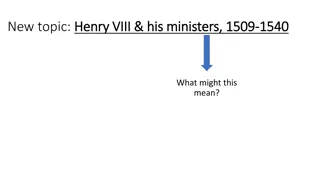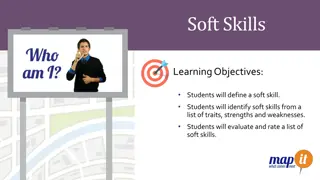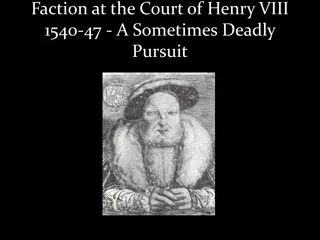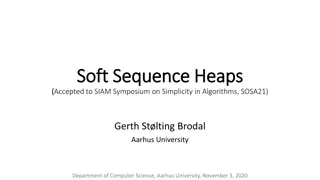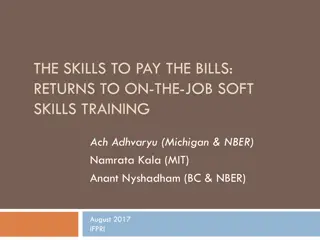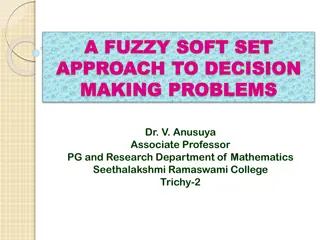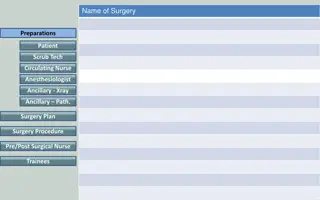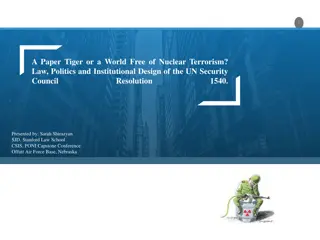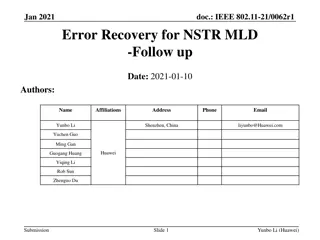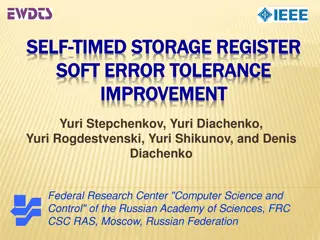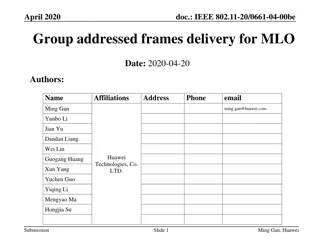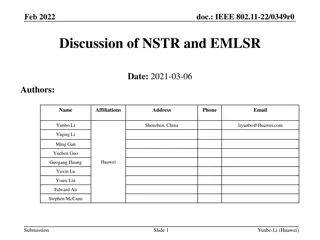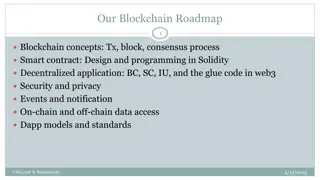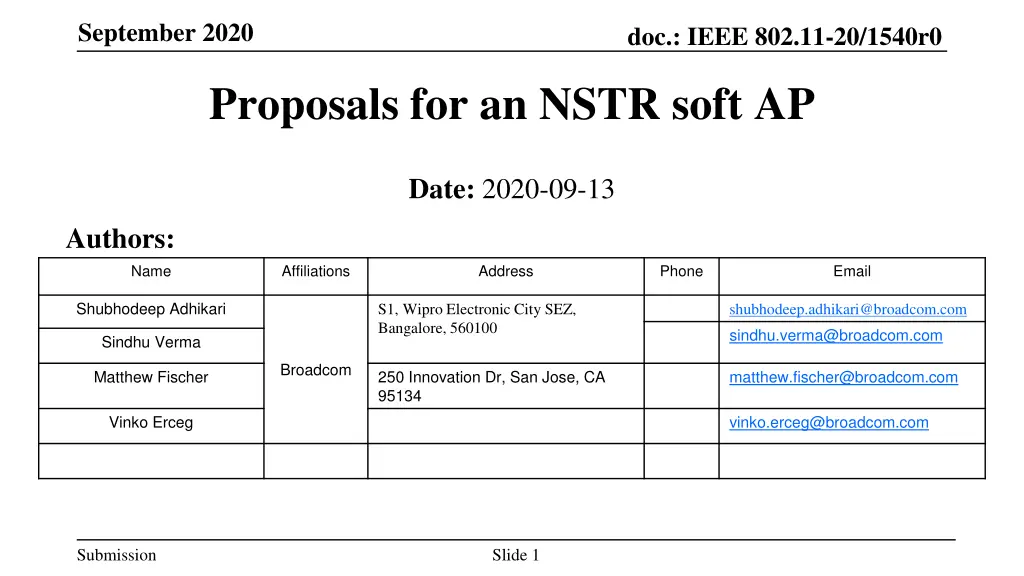
Analysis of ML Gains in NSTR Soft AP Ecosystem
Explore the importance of ML gains in the NSTR soft AP ecosystem for IEEE 802.11be standardization efforts. The analysis focuses on diversity gain and trunking gain in NSTR soft AP proposals, highlighting the challenges and benefits of such implementations.
Download Presentation

Please find below an Image/Link to download the presentation.
The content on the website is provided AS IS for your information and personal use only. It may not be sold, licensed, or shared on other websites without obtaining consent from the author. If you encounter any issues during the download, it is possible that the publisher has removed the file from their server.
You are allowed to download the files provided on this website for personal or commercial use, subject to the condition that they are used lawfully. All files are the property of their respective owners.
The content on the website is provided AS IS for your information and personal use only. It may not be sold, licensed, or shared on other websites without obtaining consent from the author.
E N D
Presentation Transcript
September 2020 doc.: IEEE 802.11-20/1540r0 Proposals for an NSTR soft AP Date: 2020-09-13 Authors: Name Affiliations Address Phone Email Shubhodeep Adhikari S1, Wipro Electronic City SEZ, Bangalore, 560100 shubhodeep.adhikari@broadcom.com sindhu.verma@broadcom.com Sindhu Verma Broadcom Matthew Fischer 250 Innovation Dr, San Jose, CA 95134 matthew.fischer@broadcom.com Vinko Erceg vinko.erceg@broadcom.com Submission Slide 1
doc.: IEEE 802.11-20/1540r0 Overview NSTR soft AP ecosystem and its importance to 802.11be Analysis of ML gains in an NSTR soft AP A baseline NSTR soft AP proposal [1] Additions and optimizations to the baseline NSTR soft AP proposal Estimated Standardization Effort (in addition to what is required to define an NSTR non-AP) Conclusion Straw Polls Submission
doc.: IEEE 802.11-20/1540r0 The NSTR soft AP ecosystem and its importance to 802.11be The configuration where a non-AP is instantiated as a soft AP and is connected to other non-APs is an important ecosystem for 802.11. There are several widely used scenarios for such a soft AP, such as Wi-Fi hotspot or tethering, peer to peer operations like streaming etc. Given the above, it is crucial for 11be to show performance gains over legacy 802.11 in this ecosystem. As ML is a key performance enhancing feature of 11be, it is thus crucial to showcase ML performance gains in this soft AP ecosystem. It is easier to get ML gains when an STR AP is connected to STR/NSTR/TDM ML (ESRML)/single-link non-APs. However, a non-AP instantiated as a soft AP is not expected to be STR over 5GHz/6GHz. This poses a challenge as, it is much more difficult to get ML gains with an NSTR AP. For this reason, the NSTR soft AP needs careful design and optimization. Submission
doc.: IEEE 802.11-20/1540r0 Analysis of ML gains in an NSTR soft AP ML gain can be split into 2 categories: Diversity gain that arises from the ability to transmit on any link within a set of multiple links. Trunking gain that arises from the ability to transmit a single flow simultaneously on multiple links. For an NSTR soft AP: Diversity gain can be obtained if a soft AP can transmit on any available link. Importantly, such gain is present irrespective of whether a soft AP is connected to an NSTR, TDM ML (ESRML) or a single link non-AP. Trunking gain is difficult to obtain, as an NSTR soft AP would need to access both links at the same time and using full EDCA on both links (as required by regulations such in as ETSI and also followed by LAA/NRU). The probability of doing so is low. Further, trunking gain can be obtained only when the NSTR soft AP is connected to NSTR non-AP(s) and not for single link non-APs. Note that some proposals in TGbe argue that a device should redraw backoff on the winning link even if it is idle, in case other link becomes busy while waiting. The motivation for doing so is to prevent collision on the winning link. This will however reduce ML gain for an AP or soft AP. Given the above, it is beneficial to analyze NSTR soft AP proposals with respect to achievability of primarily diversity gain and secondarily trunking gain. Submission
doc.: IEEE 802.11-20/1540r0 A Baseline NSTR soft AP proposal (1) IEEE 802.11-20/755r1 [1] introduced the concept of a soft AP for 11be. The proposal classifies links into basic and conditional, with the following constraints: A soft AP communicates with legacy non-APs only on the basic link A soft AP can communicate with 11be non-APs on both basic and conditional links. However the conditional link is included in a transmission only when the basic link is also included. The benefits of such a classification into basic and conditional links, with restricted access on the conditional link, are as follows: It prevents the situation where a non-AP transmits to a soft AP on a link on which the soft AP is unavailable. This is achieved for all non-APs including pre-11ax non-APs, without any need to regulate or protect untriggered UL transmissions. Is simple and without any corner case issues. Submission
doc.: IEEE 802.11-20/1540r0 A Baseline NSTR soft AP proposal (2) The downsides of such a classification into basic and conditional links are: It doesn t provide any ML diversity gain, as the conditional link can be accessed only when the basic link is available and cannot be accessed on its own. There would be no gain from the presence of an additional second (conditional) link in case the soft AP is connected to only single-link non-APs. This is because single-link non-APs must stay only on the basic link. Summary: The NSTR soft AP proposal in 755r1 provides a viable first step towards defining a soft AP in 11be. However, it provides limited ML performance gain despite requiring a dual radio non-AP in 5GHz/6GHz. Submission
doc.: IEEE 802.11-20/1540r0 Additions to the baseline NSTR soft AP proposal (1) As discussed earlier, due to the NSTR nature of a soft AP, it is challenging to achieve ML performance gains with a soft AP. In addition to the goal of achieving ML gain, the following are pertinent: Any new procedure to achieve ML gain may not be applicable to legacy non-APs. Any such procedure has to be fair to legacy non-APs. It is clear that in order to achieve ML diversity gain, the soft AP and its associated non-APs must be allowed to access the different links independent of each other, as much as is feasible under the NSTR constraints. The primary challenge in allowing unrestricted access on both links for such an NSTR soft AP is that a non-AP may then transmit to the soft AP on a link on which it is presently unavailable due to transmission/reception on another link. This would lead to packet errors and CW increases which can temporarily starve UL transmissions from the non-AP. Submission
doc.: IEEE 802.11-20/1540r0 Additions to the baseline NSTR soft AP proposal (2) Note that the problem of transmitting on a link on which the softAP is unavailable, exists only for untriggered UL transmissions from a non-AP. There can be several ways to solve this problem, some of which can be applied together: Mandate RTS/CTS before untriggered UL transmissions. It s possible for an AP to set this policy only for 11be and 11ax non-APs and not earlier. Minimize untriggered UL transmissions by setting large CW at the non-AP and manage UL data via triggered transmissions. This is similar to a cellular system. It s possible for an AP to set this policy only for 11be and 11ax non-APs and not earlier. Due to latency considerations, an exception can be made for AC_VO in unloaded conditions. Allow a soft AP to transmit CTS even when it is receiving on another link. This can be based on the soft AP s decision on whether transmission of CTS on this link will significantly interfere with reception on the other link. The CTS can indicate a NAV that aligns the end points of the receptions on the 2 links. Submission
doc.: IEEE 802.11-20/1540r0 Additions to the baseline NSTR soft AP proposal (3) Considering that most solutions to mitigate the effects of NSTR deafness cannot be applied to pre-11ax non-APs, we split the NSTR softAP ecosystem into the following two configurations and propose different solutions for each. Configuration 1: NSTR soft AP connected to non-APs a significant percentage of which are 11ax or 11be. Configuration 2: NSTR soft AP connected to non-APs a significant percentage of which are pre- 11ax. It is expected that Configuration 1 will become the most prevalent and important when 11be soft APs are commercially available. So, for Configuration 1, we propose solutions that maximize the ML diversity gain, while for Configuration 2, we propose solutions that extract whatever ML diversity gain is feasible without causing unfairness or leading to corner case issues. Submission
doc.: IEEE 802.11-20/1540r0 Additions to the baseline NSTR soft AP proposal NSTR soft AP connected to non-APs a significant % of which are 11ax or 11be (1) Proposal 1: Treat all links in a multilink set equally. Mandate RTS/CTS before untriggered UL transmissions. For 11ax, this is enabled by a soft AP setting the TXOP Duration RTS Threshold subfield to 1. Analysis No classification into basic or conditional links => a soft AP or a non-AP connected to a soft AP transmits on any link that is available. RTS/CTS before untriggered UL transmissions ensures that a soft AP does not respond with CTS if it is unavailable on the link on which RTS is sent. This ensures that a non-AP does not initiate a data transmission for the duration the soft AP is unavailable on this link. Submission
doc.: IEEE 802.11-20/1540r0 Additions to the baseline NSTR soft AP proposal NSTR soft AP connected to non-APs a significant % of which are 11ax or 11be (2) Pros: Provides significant performance gain in the crucial configuration where an NSTR soft AP is connected to 11ax or 11be non-APs. Provides ML diversity gain, as a soft AP or non-APs connected to it can use any of the multiple links. Allows distribution of single link non-APs over multiple links. So, there is diversity gain and load balancing even when a NSTR soft AP is connected to only single link non-APs. Cons: If consecutive RTSs transmitted by a non-AP fail due to the soft AP being unavailable on a link, it can lead to CW increase and temporary starvation of untriggered UL transmissions from such non-APs. In the next section we discuss optimizations to mitigate this situation. Submission
doc.: IEEE 802.11-20/1540r0 Additions to the baseline NSTR soft AP proposal NSTR soft AP connected to non-APs a significant % of which are 11ax or 11be (3) Optimization 1: Minimize or selectively allow untriggered UL transmissions. This minimizes CW increase from consecutive RTS failures when the RTSs are transmitted on the link on which the soft AP is unavailable. This can be done by: Setting large CW at the non-APs, especially for non-AC_VO access categories Scheduling most UL transmissions via the soft AP, similar to a cellular system. It is known that untriggered UL transmissions provide lower latency than triggered UL only in unloaded channels. So, deprioritizing untriggered UL transmissions, except in unloaded channels and for latency sensitive traffic, is not expected to harm UL performance. Further, untriggered UL transmissions in unloaded channels are not expected to lead to consecutive RTS failures due to unavailability of the soft AP. This is because, due to the very nature of an unloaded channel, the soft AP is expected to be in listen mode most of the time, including when an RTS is transmitted to it. Submission
doc.: IEEE 802.11-20/1540r0 Additions to the baseline NSTR soft AP proposal NSTR soft AP connected to non-APs a significant % of which are 11ax or 11be (4) Optimization 2: Reduce RTS failures for untriggered UL transmissions by allowing a soft AP to transmit CTS even if the soft AP is receiving on another link. This will be based on the soft AP s decision on whether transmission of CTS on this link will significantly interfere with reception on other link. The CTS can indicate a NAV that aligns the end points of the receptions on the 2 links. Submission
doc.: IEEE 802.11-20/1540r0 Additions to the baseline NSTR soft AP proposal NSTR soft AP connected to non-APs a significant percentage of which are pre-11ax (1) Proposal 2: Follow the basic link / conditional link scheme proposed in 802.11-20/755r1. Additionally, allow conditional link-only transmissions for the following cases: Downlink transmission by the soft AP, if it detects OBSS transmission on the basic link and for the duration of the OBSS transmission. Uplink untriggered transmission by an 11be non-AP, if it detects OBSS transmission on the basic link and for the duration of the OBSS transmission. Recommend RTS/CTS before such untriggered UL transmission. Pros: Provides some degree of ML diversity gain even when an NSTR soft AP is connected to non-APs, without penalizing UL transmissions from pre-11ax non-APs. Cons: ML gain is lower than what is achieved when an NSTR soft AP does not follow a basic link / conditional link restriction. Submission
doc.: IEEE 802.11-20/1540r0 Additions to the baseline NSTR soft AP proposal NSTR soft AP connected to non-APs a significant percentage of which are pre-11ax (2) The restrictions on conditional-link-only transmissions have the following goals: Goal 1: A soft AP transmits in a Conditional link-only manner and so becomes unavailable on the basic link only when non-APs are not expected to transmit to it on the Basic link. This goal is met if the OBSS transmission on the Basic link that is visible to the soft AP is also visible to the non-APs that intend to transmit to the soft AP on the Basic link. Even if the OBSS transmission is not visible to a given non-AP and so it transmits on the Basic link, there is no additional impact relative to what happens in existing 802.11 networks. This is because such transmissions may anyway fail due to the the presence of OBSS interference at the soft AP. Submission
doc.: IEEE 802.11-20/1540r0 Additions to the baseline NSTR soft AP proposal NSTR soft AP connected to non-APs a significant percentage of which are pre-11ax (3) The restrictions on conditional-link-only transmissions have the following goals (continued): Goal 2: An 11be non-AP transmits to a soft AP in a Conditional link-only manner only when the soft AP is expected to be available on the Conditional link. This goal is met if the OBSS transmission on the Basic link that is visible to the non-AP is also visible to the soft AP. Even if the OBSS transmission is not visible to the soft AP and if it is unavailable on the Conditional link due transmissions on the Basic link, the RTS/CTS exchange ensures that the soft AP does not respond with CTS. So, the non-AP does not initiate a data transmission for the duration the soft AP is unavailable on the Conditional link. Note that only 11be ML non-APs can access both the Basic and Conditional link. Further, they have the ability to monitor the Basic link and subsequently make an untriggered UL Conditional link-only transmission. Submission
doc.: IEEE 802.11-20/1540r0 Estimated Standardization Effort (in addition to what is required to define an NSTR non-AP) Proposal in 802.11-20/0755r1: Low to Moderate Definition of basic and conditional links Channel access on conditional link that depends on availability of the basic link Restriction of single link non-APs to basic link Proposal 1: None/Low The only requirement is RTS/CTS before untriggered UL transmissions for 11ax and 11be. Optimization 1 for Proposal 1: Low Untriggered UL transmissions can be selectively minimized and the remaining UL transmissions can be triggered in a standardized manner even today. Optimization 2 for Proposal 1: Low to moderate. Soft AP transmits CTS on a case to case basis. The standardization effort is low but the implementation effort is moderate, as it is expected that the decision to transmit CTS will be based on capability of the soft AP and may even be proprietary. Proposal 2: Low to Moderate Channel access on the conditional link based on OBSS detection on the basic link. Submission
doc.: IEEE 802.11-20/1540r0 Conclusion The configuration where an NSTR non-AP is instantiated as a soft AP and is connected to other non-APs is a widely used and important ecosystem in 802.11. So, it is important for 802.11be to show significant performance gains over legacy 802.11 in this ecosystem. ML is a key performance enhancing feature of 802.11be. It is thus crucial to showcase ML performance gains in the soft AP ecosystem. The NSTR soft AP proposal in IEEE 802.11-20/755r1 provides a viable first step towards defining a soft AP in 802.11be. In order to achieve ML gains for an NSTR soft AP, it is recommended to add schemes of the type discussed in this presentation to the proposal in IEEE 802.11-20/755r1. It is recommended to enable these schemes in a scenario-dependent configurable manner. Submission
doc.: IEEE 802.11-20/1540r0 Straw Poll 1 Do you agree to define the following mode of operation for an NSTR soft AP MLD: Treat one link in the multilink set as a basic link and another as a conditional link such that: Single-link non-APs associate with the soft AP only on the basic link. By default, data transmissions use the conditional link only if they also include the basic link. Conditional link-only transmissions are allowed in the following cases: In the DL from the soft AP, when it detects OBSS transmission on the basic link and for the duration of the OBSS transmission. In the UL from an 11be non-AP, when it detects OBSS transmission on the basic link and for the duration of OBSS transmission. It is recommended to precede such UL transmissions with an RTS/CTS. Note: The soft AP may use this mode in a configurable manner when a significant percentage of non-APs associated with it are pre-11ax. Y/N/A Submission
doc.: IEEE 802.11-20/1540r0 Straw Poll 2 Do you agree to define the following mode of operation for an NSTR soft AP MLD: Treat all links in the multilink set equally where the non-APs can associate with the soft AP on any of the links and transmissions can happen on any one or more links. RTS/CTS is recommended before untriggered UL transmissions of non-APs associated with the soft AP For 11ax, this is enabled by a softAP setting the TXOP Duration RTS Threshold subfield to 1 Note: The soft AP may use this mode in a configurable manner when a significant percentage of non-APs associated with it 11ax or 11be. Y/N/A Submission
doc.: IEEE 802.11-20/1540r0 August 2020 Reference [1] Non-STR AP Operation, IEEE 802.11-20/0755r1 [2] Draft P802.11REVmd_D3.4 [3] Draft P802.11ax_D6.1 Submission Slide 21

